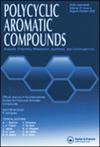用于 NLO 应用的新型有机 Brucinum-3, 5 -Dihydroxybenzoate Dihydrate 单晶的生长、结构、光谱和热分析
IF 2.4
3区 化学
Q2 CHEMISTRY, ORGANIC
引用次数: 0
摘要
根据文献中现有的高效非线性光学(NLO)有机单晶,值得介绍一种新型的 3,5-二羟基苯甲酸布鲁氏盐二水合物(B35D)有机单晶,该单晶是利用溶液在环境条件下缓慢蒸发的技术成功生长的。由于发现 B35D 在水-乙醇 1:1 混合溶剂中的溶解度是传统溶剂中最高的,因此利用该溶剂完成了 B35D 的结晶。通过单晶 X 射线衍射分析确认了晶体的晶体结构及其晶格参数,发现 B35D 结晶在单斜体系中,具有非中心对称空间群 C2。对晶体的紫外-可见-近红外透射光谱进行了记录,波长范围为 300 到 900 nm,其中较低的光学截止波长被确定为 321 nm。光致发光光谱研究在 300-600 纳米范围内进行,计算得出带隙能约为 3.8 eV(373 纳米处),表明 B35D 具有紫色荧光光谱。通过热重分析和差热分析(TG-DTA)研究了标题晶体的热稳定性和熔点,发现晶体的热稳定性为 95.6 °C。使用掺钕钇钕石榴石(Nd: YAG)Q 开关激光器获得了试样的激光诱导表面损伤阈值,估计为 3.1 GW/cm2。为了得出晶体的机械强度,还进行了维氏硬度测试。非线性光学研究表明,B35D 晶体的二阶谐波发生(SHG)效率是 KDP 的 2.16 倍。因此,B35D 晶体属于非线性光学材料。本文章由计算机程序翻译,如有差异,请以英文原文为准。
Growth, Structural, Spectroscopic and Thermal Analyses of Novel Organic Brucinum-3, 5 –Dihydroxybenzoate Dihydrate Single Crystals for NLO Applications
Along the line of available efficient nonlinear optical (NLO) organic single crystals in the literature, it is worthwhile to bring in a novel organic single crystal of Brucinium-3,5-dihydroxybenzoate dihydrate (B35D) which was successfully grown utilizing the technique of slow evaporation of solution at ambient conditions. As the solubility of B35D was found to be the highest in water-ethanol 1:1 mixed solvent among the conventional solvents, crystallization of B35D was accomplished by making use of the solvent. The required confirmation of the crystal structure of the crystal and its lattice parameter could be achieved by the single-crystal X-ray diffraction analysis such that B35D was found to be crystallized in the monoclinic system with the non-centrosymmetric space group C2. The recording of UV-Vis-NIR transmittance spectrum of the crystal was undertaken between the range of 300 and 900 nm whereby the lower optical cutoff wavelength was identified to be 321 nm. The spectral study of photoluminescence was carried out in the range of 300-600 nm by which the band gap energy was calculated to be about 3.8 eV (at 373 nm) indicating that B35D has a violet fluorescence spectrum. The thermal stability and melting point of the title crystal have been investigated through Thermo gravimetric and differential thermal analysis (TG-DTA) such that the thermal stability of the crystal was found to be 95.6 °C. The Nd: YAG Q-switched laser was employed so as to obtain the laser-induced surface damage threshold of the specimen which was estimated to be 3.1 GW/cm2. The Vickers microhardness test was implemented in order to arrive at the mechanical strength of the crystal. The performed non-linear optical study could reveal that the second-order harmonic generation (SHG) efficiency of B35D crystal is 2.16 times higher than KDP. So that B35D crystals are among the class of NLO materials.
求助全文
通过发布文献求助,成功后即可免费获取论文全文。
去求助
来源期刊

Polycyclic Aromatic Compounds
化学-有机化学
CiteScore
3.70
自引率
20.80%
发文量
412
审稿时长
3 months
期刊介绍:
The purpose of Polycyclic Aromatic Compounds is to provide an international and interdisciplinary forum for all aspects of research related to polycyclic aromatic compounds (PAC). Topics range from fundamental research in chemistry (including synthetic and theoretical chemistry) and physics (including astrophysics), as well as thermodynamics, spectroscopy, analytical methods, and biology to applied studies in environmental science, biochemistry, toxicology, and industry. Polycyclic Aromatic Compounds has an outstanding Editorial Board and offers a rapid and efficient peer review process, as well as a flexible open access policy.
 求助内容:
求助内容: 应助结果提醒方式:
应助结果提醒方式:


